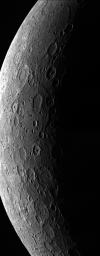
|
Through the Ages
- Click the image above for a larger view
- Full-Res JPEG (790 x 2028) (257.0 kB)
- Full-Res TIFF (790 x 2028) (1.6 MB)
Caption:
This mosaic was created by combining two images that were taken 96 seconds apart. The MESSENGER spacecraft has to be farther from the planet, in the southern portion of its orbit , to acquire these views. Mercury's cratered surface is highlighted dramatically near the terminator (the division between the sunlit dayside and the dark nightside of the planet), reflecting Mercury's history of being battered by impacting objects through the ages.
This image was acquired as part of MDIS's limb imaging campaign. Once per week, MDIS captures images of Mercury's limb, with an emphasis on imaging the southern hemisphere limb. These limb images provide information about Mercury's shape and complement measurements of topography made by the Mercury Laser Altimeter (MLA) of Mercury's northern hemisphere.
Date acquired:
May 07, 2013
Image Mission Elapsed Time (MET):
10234404, 10234500
Image ID:
4021801, 4021802
Instrument:
Wide Angle Camera (WAC) of the Mercury Dual Imaging System (MDIS)
WAC filter:
7 (748 nanometers)
Center Latitude:
-60°
Center Longitude:
260° E
Scale:
Mercury's diameter is 4880 kilometers (3030 miles)
Background Info:
The MESSENGER spacecraft is the first ever to orbit the planet Mercury, and the spacecraft's seven scientific instruments and radio science investigation are unraveling the history and evolution of the Solar System's innermost planet. MESSENGER acquired over 150,000 images and extensive other data sets. MESSENGER is capable of continuing orbital operations until early 2015.
For information regarding the use of images, see the MESSENGER image use policy .
Cataloging Keywords:
| Name | Value | Additional Values |
|---|---|---|
| Target | Mercury | |
| System | ||
| Target Type | Planet | |
| Mission | MESSENGER | |
| Instrument Host | MESSENGER | |
| Host Type | Orbiter | |
| Instrument | Mercury Dual Imaging System (MDIS) | |
| Detector | Wide Angle Camera (WAC) | |
| Extra Keywords | Crater, Grayscale, Impact, Radio | |
| Acquisition Date | ||
| Release Date | 2013-05-30 | |
| Date in Caption | 2013-05-07 | |
| Image Credit | NASA/Johns Hopkins University Applied Physics Laboratory/Carnegie Institution of Washington | |
| Source | photojournal.jpl.nasa.gov/catalog/PIA17229 | |
| Identifier | PIA17229 | |
